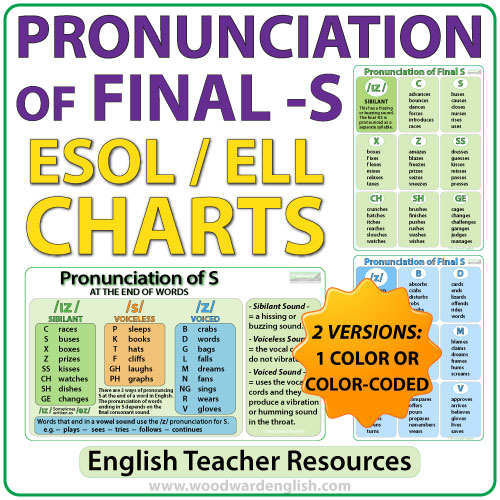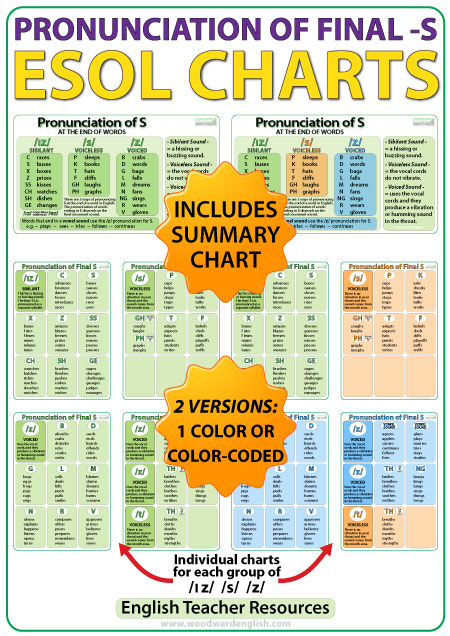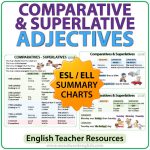Description
Pronunciation of -S at the end of words – ESOL / ELL Charts
Why does the ending of sleeps sound like a S, the end of dreams sound like a Z, and the end of races is a whole new syllable with a sound like IZ?
There are three ways of pronouncing the final S at the end of words in English:
/s/, /z/, or /iz/.
Our charts explains the general rules for the pronunciation of words ending in –S. These words are normally regular plural nouns or third person verbs in the simple present tense.
This resource is ideal for teenage or adult ESL/ELL students to help them sound more like a native speaker. It is a great reference guide to help accent modification.
Summary Chart
The first chart is a summary of how to pronounce the final -S showing /iz/, /s/, or /z/ endings with examples.
Summary Chart – Smaller 2 per page version
Then we have a smaller version of this same chart with two of them on one page (surrounded by cutting lines).
/iz/ Pronunciation Chart
This chart contains examples of words that end with a sibilant sound giving us the /iz/ pronunciation (and extra syllable) when adding an S to the end. There is a box for each letter (C, S, X, Z, SS, CH, SH, GE) and six examples of that letter (e.g. for C are the words advances, bounces, dances, forces, introduces, and races).
/s/ Pronunciation Chart
This chart contains examples of words that end with the voiceless /s/ pronunciation. There is a box for each letter (P, K, T and F) with six examples for each letter. GH and PH are in the same box with two examples for each. There are three blank boxes at the bottom of the page which can be used for additional notes or examples if desired.
/z/ Pronunciation Chart
This chart contains examples of words that end with the voiced /z/ pronunciation. There is a box for each letter (B, D, G, L, M, N, R and V) with six examples for each letter.
Pronunciation Mix Chart
The final chart contains a variety rules:
VOWEL SOUND: There are 12 examples of verbs that end in a vowel sound that have the voiced /z/ pronunciation at the end (e.g. agrees, plays, etc.).
NG: We look at how the letter S after NG sounds like a Z thus having a voiced /z/ ending. (6 examples of words ending in NGS)
TH: There are two ways of pronouncing TH (ð and θ). Words that end in the voiced dental fricative TH /ð/ have a voiced pronunciation of the final S ending. We give six examples of words ending in this way (e.g. bathes, breathes, clothes…)
Words that end in the voiceless dental fricative /θ/ have a voiceless pronunciation of the final S ending. We give six examples of words ending in this way (e.g. breaths, months, strengths…)
There are two versions of these charts, one that is designed in one color (green) and the other is with color-coding of /iz/ in green, /s/ in orange, and /z/ in blue. Check the preview to see this difference.
I have also created a pronunciation video on YouTube about this topic: Final S pronunciation in English – How to pronounce words ending in S (Suitable for the classroom).
CONTENT: This resource contains 12 Pages:
Color-coded Version:
- Pronunciation of Final S – Summary Chart – (1 page)
- Pronunciation of Final S – Summary Chart – Smaller Version – (1 page)
- Sibilant /iz/ Chart – (1 page)
- Voiceless /s/ Chart – (1 page)
- Voiced /z/ Chart – (1 page)
- Additional Chart – Vowels, TH and NG – (1 page)
One-color (green) Version:
- Pronunciation of Final S – Summary Chart – (1 page)
- Pronunciation of Final S – Summary Chart – Smaller Version – (1 page)
- Sibilant /iz/ Chart – (1 page)
- Voiceless /s/ Chart – (1 page)
- Voiced /z/ Chart – (1 page)
- Additional Chart – Vowels, TH and NG – (1 page)
LEVEL: Intermediate (CEFR – B1 Level)
AGE: 10+
Format: .PDF
Afiches para aprender la pronunciación de palabras que terminan con S en inglés.






